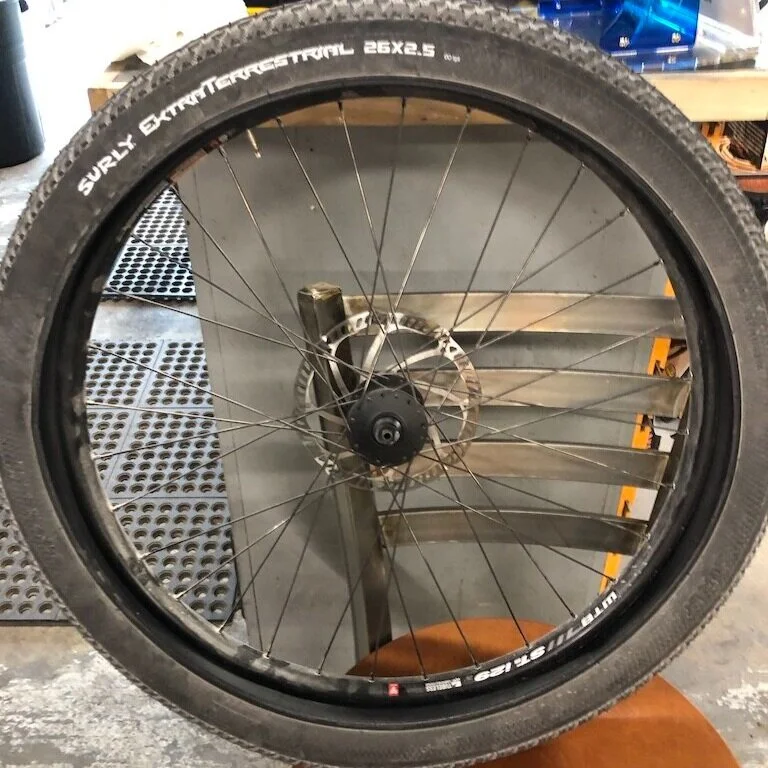What’s Deal with Wheel Sizes?
26” 650b 27.5” 700c 29er…what’s the deal?
Wheel sizes (and tire sizes) come in a variety of sizes and are referenced differently. The overlap can be confusing. We’ll try to spell it out for you as simply as we can.
We get questions about wheel sizes a lot, which is fair since bike culture has relished the lack of standardization and confusing terminology. For example, 650b and 27.5” are the same size wheels as are 29er’s and 700c. Depending on where you shop for your tires and wheelsets, the difference (and benefits or drawbacks) may be hard to ascertain. To get into the wheel and tire size variance conversation at a local bike shop can feel like a crash course in the history of wheel development over the course of the past 20 years. Numbers can be thrown around that make your head spin and heaven help you if you get into ETRTO (the international tire sizing standard numbers) discussion. So we’ll keep it as simple as possible for you to make your next wheel set or tire purchase feel less intimidating and you feeling more informed.
Wheel Sizes
The wheel size for your bike is quite often already chosen for you by the bike manufacturer based on the type of riding they intend the bike to be used for. Along with riding style, they take into consideration the ideal riding experience for the bicyclist by choosing a wheel size that makes the bike feel it’s best right off the sales floor. But more riders are finding the beauty of owning two wheel sets for their bicycle and bicycle manufacturers are also creating bike frame designs that allow the wheel set sizes to be interchangeable without impeding the ride quality or feel of the bike ride. It’s pretty cool. So let’s dig into this a little bit more.
Wheels come in two basic sizes, but there are 4 types of terminology when referring to them (it’s confusing, we know). Currently the bicycle industry uses 700c (also 29er) and 650b (also 27.5) as the wheel sizes they design bikes around. What you need to know is that the lingo is divided between the road/gravel community and the mountain biking community. With the constant evolution of gravel bikes and drop bar mountain bikes, there is definitely an increasing overlap among the lingo. But for now, those two categories should suffice.
700c and 29er
The 700c and 29er are essentially the same wheel size when it comes to the diameter of the wheel. If you ride a road bike or a gravel bike, you most likely have a 700c rim to work with. If you ride a full suspension mountain bike or a modern day hard tail mountain bike with some serious suspension forks, you’re probably rolling on 29er rims. The main difference between the two is the width of the rim. Obviously, if you have a wider rim, you’ll be able to put wider tires on the rim. This works great for mountain bikes that are riding through harsh single track and tackling terrain most road bikes wouldn’t attempt. More rubber, more knobbies, and such a tall tire provides the bike advantages in clearing rocks, roots, etc for mountain bike trails.
As we mentioned previously, there is beginning to be overlap between the 29er/700c categorizations between road/gravel and the mountain bike scene thanks to the evolving world of gravel bikes. For example, Salsa Cutthroats are great gravel bikes, but they come with 29er’s. This allows them to also do some more adventurous trail riding that you may not take a 700c wheelset on because you may not be able to fit a wide enough tire on your rim. The frame design and fork design play a major role in how much room you have for tires, but again, it seems every year, the space between the chainstays and seatstays along with the fork is ever widening.
650b and 27.5
The 650b/27.5 wheel sizes follow the same logic as the 700c/29er wheel sets. The number refers to the diameter of the wheel. If you’re riding gravel (and some city bikes) you’re going to be riding 650b and if you’re riding a mountain bike they’re termed as 27.5. So once again, the bike scene you’re in determines how the size is referenced. Recently, it seems that the 27.5 wheelsets are losing ground to the 29er’s. However, you can put wider tires on the 650b/27.5 wheelsets than the 700c/29er counterparts. Since the diameter of the 650/27.5 wheelset is less than the 700c/29er, the rims sit lower in the fork and further back in the rear triangle which means it gives you more room for wider tires since there is greater clearance in the bike frame based on where they sit once the wheel is installed. More rubber means more cushion for riding. For bikepacking and gravel grinding, 650b’s remain a popular choice for riders. There are also some bike manufacturers the utilize 27.5 wheelsets for their mountain bikes because they want to put 3.0” wide tires on the bike providing even more cushion and grip for trail riding.
Interchangeability
A post about the difference in wheel sizes wouldn’t be complete in our opinion without at least discussing the benefits of swapping out tire sizes. As more riders find out about the benefits of the gravel bike/all-road bike revolution (which we’ll have a post about in the near future), the interest in owning a second wheelset has increased. Why would riders want to own two sets of wheels? The answer depends on the type of riding you like to do. Most riders like the zippy feel of 700c tires as they commute or ride their weekend rides on mainly asphalt routes. But there may be times that the rider wants to put a bit more of a load on the bike and do an overnight or weekend bike pack. While you can do these types of rides on 700c wheelsets, folks find 650b wheels to be more nimble and comfortable while carrying a loaded bike. As mentioned earlier, 650b wheelsets are less in diameter than their 700c counterparts which means they lower the stand over height of the bike, allow for wider tires, and both of these things provide benefits when riding with a loaded bicycle. Having bikes that allow for wheel size swaps without negatively impacting the ride quality is a great benefit of the gravel bike industry. A bicyclist now may have a new equation to consider along with n +1 that takes into account owning a second wheelset. I’ll leave it to my smarter math friends to devise that formula.
Hop this post helped clarify all the esoteric language of wheel sizes. Or at the very least, let you know you’re not crazy: the terminology was/is confusing. Ride safe!



